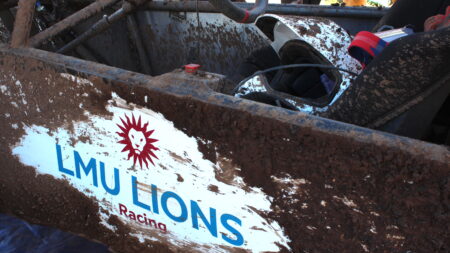
Following a year of fabrication and preparation, the Baja Lions Racing Team won third place in the “Rock Crawl” contest at the 2023 Baja SAE Oregon competition.
The team included mechanical engineering majors John Vanderwey, president of the revitalized Baja Lions Racing Club, Cameron Hagey, Jack Seidenfeld, Alec Britt, Sunil Klein, Sean Hornchek, as well as Aidan Smith-Fagan, Brayden Fergason, Robert Stanley. The team’s faculty advisor was Emin Issakhanian, associate professor of mechanical engineering.
At the end of May, the team travelled to Washougal, WA for the 2023 SAE Baja Oregon Competition. The four-day event was open to one hundred universities from around the world. The competition was the culmination of months of preparation, which included testing and fine-tuning the car, and watching Baja competitions to learn from other teams.

The first hurdle was to pass the technical inspection, which happens in the first two days of the competition. “Only about twenty percent of teams passed the tech inspection on the first day,” says Vanderwey.
After passing the inspection, it was time to put their skills and car to the test. The competition included a four-hour endurance race during which teams had to complete as many laps as possible, as well as a static event, and four dynamic events: acceleration, hill climb, maneuverability, and of course, the rock crawl.
The rock crawl pushes both car and driver to the limits by climbing a steep, obstacle-ridden hill. Each team is given two chances on the rock crawl, as well as the opportunity to walk through the course beforehand.
The Baja Lions Racing Club opted to make a car with bigger tires and beefier suspension, which posed an initial challenge in the event. “The first turn that you have to take is super tight and narrow and even these smaller vehicles couldn’t make it. Because we had a long vehicle we were like ‘shoot, how are we going to do it’?” Vanderwey says.
The second challenge was that their gearbox didn’t have a clutch in it, so the driver couldn’t change gears without first shutting off the engine nor could they put it in reverse.
As they started the rock crawl, they realized that the solution lay hidden in something they had seen in the technical inspection. “I didn’t know you could do it until the tech inspectors did it. They pushed the engine kill switch and then pulled it back out quickly, which stalls the engine for a second,” Vanderwey explains. Using this strategy, he was able to switch gears to better maneuver the rock crawl.

The Baja Lions Racing Club won third place in the rock crawl and was the fourth team to finish that event. “That was a cool moment,” says Vanderwey, “it was great to see all the guys having fun.”
“Seeing the younger team members participate and fabricate some new things was fantastic, and I’m looking forward to the future of the club,” says Vanderwey. As he completes his final semester in the fall, Vanderwey has passed the reigns of club president to rising junior Jack Seidenfeld, while Vanderwey has become club treasurer.
Professor Issakhanian, who advised the project from the beginning, came to the competition and supplied the team with crucial items to help keep them on track.
It was quite a debut for the Baja Lions Racing Club, after being dormant for a few years. See the project’s origin story, how it started as a partially fabricated chassis stored in the Cheryl and Robert Gross Engineering Design Center and went on to become a capstone project for several seniors.
Noémie Boucher ’25



